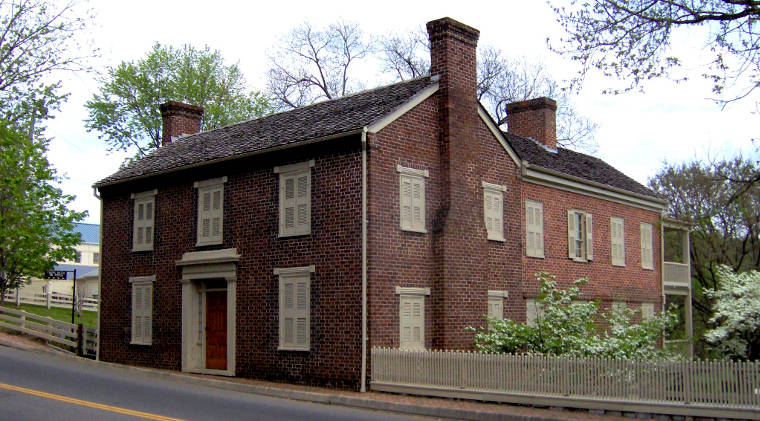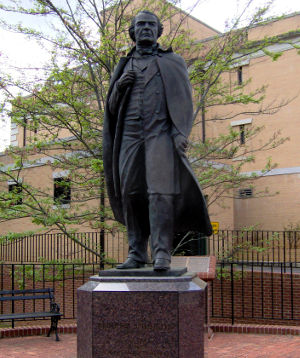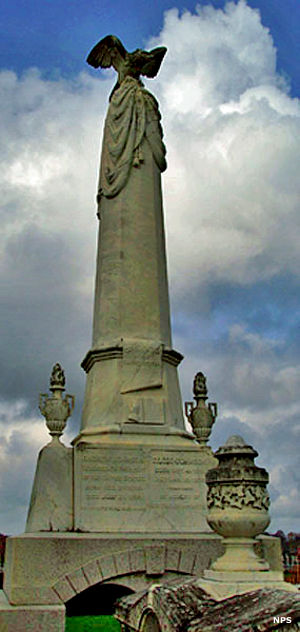Andrew Johnson National Historic Site

The Andrew Johnson home in Greeneville, TN

Andrew Johnson was the 17th President of the United States, assuming the office after the assassination of Abraham Lincoln. Being a Tennessee politician who did not secede with the state during the Civil War, he was a logical choice to run for office as Lincoln's Vice President in 1864. After they easily won the election, Johnson gave a rambling speech at the inauguration ceremony, then hid for six weeks, only coming out after Lincoln was assassinated and he became President.
Andrew Johnson began life in Raleigh, North Carolina, the son of English and Scots-Irish immigrants. He was born in a log cabin, a great recommendation for politicians in the 1800's. He was apprenticed to James Selby, a tailor, when he was ten years old. The apprenticeship "contract" was supposed to last until he turned 21 but at 15 he and his brother tired of the horrible working and living conditions and both ran away. He wandered around North Carolina for a couple years, then tried to buy himself out of the apprenticeship. When that didn't work, he relocated to Tennessee. Not long after, he returned to North Carolina to help his mother and step-father relocate to Tennessee. They made the journey and passed through the Blue Ridge Mountains to arrive in Greeneville. Johnson fell in love with Greeneville at first sight. He set up as a tailor and shortly was prosperous enough to purchase the land on which he had first camped. When he was 18 he married 16-year-old Eliza McCardle, the daughter of a local shoemaker. As he never attended a day of school in his life, he had rudimentary literacy skills and she spent many years tutoring him to improve his mathematics, his reading and his writing. Together they had five children: two daughters and three sons. Two of the son's died before the parents and the third, Andrew Johnson, Jr., died at the age of 27 after failing as a local newspaper publisher. Somewhere along the way Eliza developed tuberculosis and her increasingly poor health hampered her ability to work with her husband in public, although she did attend two public occasions while in the White House: the visit of Queen Emma from Hawaii in 1866 and the President's birthday in 1867. Otherwise she was confined to her room on the second floor. She died in Greeneville, Tennessee, in 1876, just five-and-a-half months after her husband.
After the Civil War, Johnson pushed for bringing the Confederate states back into the Union quickly but those states wanted to return many "Confederacy-tainted" representatives to office. The Radical Republican Congress refused to seat them. The newly elected southern governments also passed a lot of laws designed to keep the former slaves "in their place" and Congress worked to overturn those laws (and obviously, that battle is still being fought in 2020 as Republican-controlled governments at all levels continue to work behind the scenes to control African-Americans (and other minorities) and disenfranchise them from their birthrights as American citizens).
Johnson vetoed those bills from Congress but Congress then overrode his vetoes, setting the stage for what has been rated as one of the worst presidencies in American history. Johnson also opposed the Fourteenth Amendment to the Constitution, an amendment giving American citizenship to African-Americans. In general, Johnson was against the cause of African-American rights. He eventually became the first President to be impeached by Congress, although the Senate saved him by one vote. On Christmas Day in 1868, Johnson issued an Executive Proclamation giving full amnesty to all those who had served in the government and military of the Confederacy, further infuriating the Radical Republicans. In 1869 he left the White House and returned to his home in Greeneville, Tennessee, where he worked to try to restore his good name. In 1875 Tennessee voters elected him to the Senate (the only former President to become a Senator) but he died only six months later.
The Andrew Johnson National Historic Site is composed of three units: the Visitor Complex, the Homestead and the Andrew Johnson National Cemetery. The Visitor Complex contains the visitor center, the Andrew Johnson Museum and the tailor shop frequented by Johnson. In 1923 the State of Tennessee erected a memorial building around the tailor shop to protect it from the elements but the one-room shop itself is kept as it was in the 1870's. Johnson's first home in Greeneville is located directly across the street from the Visitor Complex. The Historic Site was originally authorized by Congress in 1935 and inaugurated by President Franklin D. Roosevelt in 1942. The property was redesignated the Andrew Johnson National Historic Site in 1965.
The Homestead is a property Johnson purchased in 1851 but didn't really occupy himself until 1869. During the war years the home had been occupied by Confederate soldiers and needed extensive renovation before Johnson and his wife could live there again. The two-story Greek-revival brick house is presently maintained as it was in the time of Johnson's life.

The statue above Andrew Johnson's grave
The Andrew Johnson National Cemetery is composed of 23 acres on Signal Hill, just outside Greeneville. Johnson had bought the property in 1852 because he so enjoyed the view. He was buried there in 1875 and in 1878, a 28-foot-tall marble statue was placed beside the grave. The statue was so prominent the site became known as Monument Hill. In 1898 Johnson's daughter willed the parcel to become a park. Then in 1900 she pushed further to make the park a National Cemetery. Congress granted that wish in 1906 and the US War Department took control of the property in 1908. Several of Johnson's family members were buried there and by 1939, there were almost 100 graves on the hill. In 1942 control of the property was given to the National Park Service and they immediately stopped any future interments on the land in the name of preserving the historic property "as is." That led to efforts by the American Legion and the Daughters of the American Revolution that succeeded in reopening the cemetery to the internment of soldiers from both World Wars, Korea, Vietnam and the Gulf War. Andrew Johnson National Cemetery and Andersonville National Cemetery are the only two properties controlled by the US Department of the Interior that allow internments still.
The Park Service also hands out entrance tickets for Johnson's impeachment trial every year and takes votes from the visitors as to whether or not Johnson should have been impeached and removed from office. His crowning achievement was the passage of the Homestead Act, whereby 160-acre parcels of public land could be claimed by any citizen willing to work that land and meet the basic requirements of ownership: build a cabin with a door and window, farm or ranch on the land and occupy the property for at least five years. Johnson also approved the purchase of Alaska in 1867 and the annexation of Midway Island. It was also in 1868 that the first successful Transatlantic Cable was laid and the US could communicate with Europe via telegraph. Johnson was also the first president to host an Easter Egg Roll at the White House and on his 60th birthday, he invited 300 children into the White House for the party.
A small note: Johnson purchased his first slave shortly after taking a seat in the Tennessee House of Representatives in 1835. Her name was Dolly and she was 14 years old. Over the years the dark-skinned girl/woman had several significantly lighter children, leading to speculation Johnson was the father. In 1862 the Union had recovered most of western and central Tennessee and Lincoln appointed Johnson to be the military governor of the state. In response, the Confederate government that was still in control of eastern Tennessee confiscated his land and slaves, told Eliza Johnson to get out and then turned their home into a military hospital. So while he was against the Confederacy as a secessionist government, he was also pro-slavery and after being seated in the Senate in 1860, tried to convince southern senators that they would be in control of Congress and they would be able to stop Lincoln from passing any of his proposed reforms against slavery. Instead, the majority of southern Representatives and Senators opted for the military solution over the political one and here we are in 2020, still fighting it out. Except now it's not just in the South but spread all across the country...
The Andrew Johnson National Historic Site is open every day of the year except Thanksgiving, Christmas and New Year's Days, from 9 am to 5 pm. Tours of the Homestead are offered daily at 10:30, 11:30, 1:30, 2:30 and 3:30. The Andrew Johnson National Cemetery is open during the same hours but is open until 7 pm on Memorial Day only. The entire Site may be closed due to nasty winter weather while the Homestead may be closed in summer due to high temperatures. There are no visitor fees involved.
Lower right photo courtesy of the National Park Service